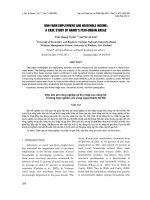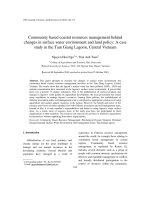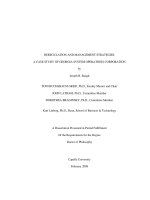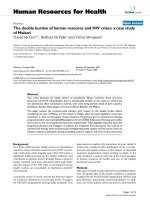Invisible Mutuality between Structural Inertia and Learning Disablity - A Case study of the West Japan Railway Accident 4.25
Bạn đang xem bản rút gọn của tài liệu. Xem và tải ngay bản đầy đủ của tài liệu tại đây (1.09 MB, 15 trang )
<span class='text_page_counter'>(1)</span><div class='page_container' data-page=1>
2013iF3~
</div>
<span class='text_page_counter'>(2)</span><div class='page_container' data-page=2>
<b>.-</b>
c,../.
;}
i
j
1
Invisible Mutuality between Structural Inertia and Learning Disability
A Case Study of the West Japan Railway Accident 4.25
-... : Shigeo ATSUJI, Nguyen Ngoc Thang
Kazunori UEDA ( 1 )
Internet Ethics Issues and Actions in Japan EZAWA Yoshinori (15)
tHt EI89'iFn.UH-
';J7'
-If';J7
r,,~M
<i>0)</i>JZ
<i>ffl</i>
<i>t</i>
PItJHt
... {rflIII ~
=.
<i>L~</i>
<i>~-.</i>
it
/-7"/' D. 7 ';J7
</div>
<span class='text_page_counter'>(3)</span><div class='page_container' data-page=3>
<b>Invisible Mutuality between Structural Inertia</b>
<b>and Learning Disability</b>
-
A Case Study of the West Japan Railway Accident 4.25
-Shigeo ATsun* I Nguyen Ngoc Thang*2
Abstract
Kazunori UEDA *3
]
This article examines a case study of the JR (Japan Railways) West accident, which was
the worst railway accident in Japanese history. The purpose of this research is to prevent
similar accidents by focusing on organizational 'learning disabilities' (Garvin, 2000). We
review firstly a summary of the JR accident. Secondly we review the irrational behaviour of
the driver involved, which originated in the system of re-education of the JR West
Company known as 'Nikkin Kyoiku'. Thirdly, we examine the interference with
organiza-tionallearning bounded by 'structural inertia', and finally, we review the 'organizational
disaster' in relation to the 'learning disability'. This research is concerned with compliance
and corporate governance.
Key words: organizationaldisaster,learningdisabilities,structuralinertia,compliance,governance
., Kansai University Faculty of Informatics
., University of Economics and Business, Vietnam National University, Hanoi
.3 Kansai University Graduate School of Informatics, with improvement by Professor Norman D. Cook
</div>
<span class='text_page_counter'>(4)</span><div class='page_container' data-page=4>
2 2013"1'- 3 FJ
I. JR West Accident 4.25: Accident or Disaster?
Since the advent of railway-based society, tragic railway accidents have occurred in all time
periods and countries, despite great progress being achieved every year in mechanical technology.
For instance, 23 people died in Canada which accident occurred in 1986, 56 people died in France
(1988), 101 people died in Germany in (1998), and more recently, 71 people lost their lives in
China (2008), all due to railway accidents. Figure 1 shows accidents that have incurred many
fatalities since 1980. Although the countries mentioned enjoy comparatively advanced technology,
these accidents claimed many lives.
JR is the common name of the Japan Railways, the largest railway conglomerate in Japan, which
has a history dating back to the privatisation of the Japanese National Railway (JNR) in 1987. On
25 April 2005, a derailment accident occurred on the Fukuchiyama Line of the Japan Railway West
Company. In this accident, 106 passengers and the driver died, and 562 others were injured. The
accident was investigated by the Aircraft and Railway Accident Investigation Commission (ARAIC),
whose findings were released as the "Fukuchiyama Line Derailment Accident Investigation Report"
<i>(hereafter, ARAIC's</i> <i>Report)</i> in June 2007. Figure 2 shows the derailment situation of the railcars
during the accident site.
Just before the crash, the train overran its intended position at the previous station by
approxi-mately 72 meters. Because of an adjustment back to correct the location at the station, the train
departed from Itami with a delay of 90 seconds. It passed through Tsukaguchi, which is the station
following Itami on the route to Osaka, with a delay of 60 seconds. The train travelled at 116 km/h
<b>accident's name: victims</b>
<b>,Figure 1</b> <b>Railway accidents with many fatalities since 1980</b>
(source: Nikkei Telecom 21).
I
1
,I
I
I
1
</div>
<span class='text_page_counter'>(5)</span><div class='page_container' data-page=5>
ed in all time
;al technology.
died in France
their lives in
incurred many
ed technology,
n Japan, which
~) in 1987, On
Railway West
'e injured. The
sion (ARAIC),
gation Report"
of the railcars
on by
approxi-ltion, the train
1is the station
:d at 116 kmJh
cciden!: 107
2005, Japan
J
1
-I Invisible lIJutllalit\, between Structural Inertia ,lod Learning Disability
<b>1st</b> <b>block</b> <b>signal</b> <b>(down</b> <b>line)</b>
<b>Figure 2</b> <b>Derailment</b> <b>situation of train</b>
<i>(source: ARAIC's Report 2007)</i>
</div>
<span class='text_page_counter'>(6)</span><div class='page_container' data-page=6>
4
i
1
I
,
on this section to make up for the time lost due to the overrun, and it then derailed on the curve
between Tsukaguchi station and Amagasaki station on the JR Fukuchiyama Line. The excessive
speed caused the two front cars to crash into an apartment building after derailment. The upper
speed limit at the site was 70 km/h on a curve of 300-meter radius. In addition, the JR West had a
congested railway schedule due to competition with other private railway companies. These
situations are the cause of the driver's speeding.
<b>II. 'Administrative</b> Limitation' of 'Nikkin Kyoiku' as Organizational Disaster
The driver had not perfonned driving operations for 40 seconds just prior to the accident but had
monitored the radio exchange between the conductor and the dispatcher and had made a note of it.
The background <i>to the driver's actions was described in the ARAIC</i>
s
<i>Report as follows: "There was</i>concern about the 'Nikkin Kyoiku' system, which is the JR West's re-educational system, and the
punitive measures that were experienced in the past". Figure 3 shows the dialogue between the
driver, conductor and control dispatcher immediately before the accident took place (following
Figure 8: <i>a).</i>
In this accident, while in actuality the train overran by approximately 72 meters at Itami-Station,
the driver asked the conductor to submit a false report. The conductor accepted the request from the
driver: "Please shorten the distance of the overrun" and reported an "8-meter overrun and 90-second
delay" to the control dispatcher of train service management. The control dispatcher made contact
with the driver for confirmation. The driver was in a dangerous situation because the reported
8-meter overrun is inconsistent with a delay of 90-second, as became clear from the train service
recorder immediately <i>after the train crashed. The ARAICs</i> <i>report noted that the driver's</i> dangerous
driving was caused by fear of 'Nikkin Kyoiku', which he had experienced in his past. Figure 4
shows the handwritten memo which the driver was taking until the accident took place. The driver
took the memo while operating the train for his 'self-defense' for 40 seconds he was not driving.
'Nikkin Kyoiku' is the re-educational system carried out for the purpose of preventing accidents
and incidents, but a part of this system consists of punitive measures. This function is perfonned
from 9:00 to 17:45 in the 'office work room' of each train division. This room is a space for office
workers and administrators, and those who receive 'Nikkin Kyoiku' sit in the position labelled
'driver' in Figure 5. These personnel are required to work all day on a report under the supervision
of an administrator or office personnel. Members \-vho have received 'Nikkin Kyoiku' say "My
ewposure to the other members made me feel uncomfortable."
'Nikkin Kyoiku' mainly consists of report writing, and it also includes a test that measures the
driver's basic knowledge. However, the educator in charge determines the actual work content in
,i
l
</div>
<span class='text_page_counter'>(7)</span><div class='page_container' data-page=7>
on the curve
rhe excessive
It. The upper
R West had a
Janies. These
cident but had
e a note of it.
's: "There was
'stem, and the
~ between the
Ice (following
t Itami-Station,
quest from the
and 90-second
made contact
e the reported
e train service
er's dangerous
past. Figure 4
Ice. The driver
not driving,
nting accidents
n is performed
;pace for office
)sition labelled
the supervision
oiku' say "My
it measures the
vork content in
..
~
;~.';',,' ',""",\'l'I""" -;"~,,.
Invisible Mutuality oetween Structural Inertia and Learning Disability
passed through Tsukaguchi
<b>Figure 3</b> <b>Dialogue of the JR West accident 4.25</b>
(source: ARAIC, 2006, ppA-16, pp.34- 37).
3~'1i'
~t':l ]~1o'rB ';!,6'l
*"
<i><b>1:.</b></i> <i><b>II]</b></i>
IgJ,~
t~/\iGI
<b>Figure 4</b> <b>Driver's original memo (Japanese evidence)</b>
(source: ARAIC, 2006).
</div>
<span class='text_page_counter'>(8)</span><div class='page_container' data-page=8>
6
2013.:$ 3 FJ
<b>Figure 5</b> <b>The situation of 'Nikkin Kyoiku' in the JR West</b>
(source: Suzuki et aI., 2007, p.67).
The driver involved in the accident described above had experienced 'Nikkin Kyoiku' three
times, for a total of 18 days. In addition, the d~iver occasionally complained to his friend that "I
must write text all day long and need permission even to go to the toilet", as described in the
<i>ARAIC's Report. Following the accident, on June I, 2005, a questionnaire</i> was distributed to 3,096
drivers by the West Japan Railway Union, and 2,676 responded. Over 25% of the respondents
'Nikkin Kyoiku', and questionable chores of a 'punitive' character are also included, such as
longhand 'copying of work rules' and 'weeding of train tracks or flower beds', as reported after this
accident. In addition, anyone who undergoes 'Nikkin Kyoiku' may have his salary reduced.
Such a punitive education method is an example of the type of education method that former
Japanese companies and the Japanese armed forces often adopted. One problem associated with this
educational method is that it depends excessively on personal spiritual strength and concentration
without investigating the cause of the failure.
Table I shows the number of suicides that have occurred at the JR West Company. From 2000
to 2005, 18 employees committed suicide, and on average, four people take their own lives each
year. There are six railway companies in the JR Group each operating in a separate region: JR
Hokkaido, JR East, JR Central, JR West, JR Shikoku, and JR Kyushu. No data exist regarding the
number of employees overall who have killed themselves, and only JR West has been brought to the
public attention. Although it cannot be concluded that the direct cause of these suicides is 'Nikkin
Kyoiku', there is the possibility that problems exist under JR West's management (following Figure
8: y).
</div>
<span class='text_page_counter'>(9)</span><div class='page_container' data-page=9>
the date of suicide situation the date of suicide situation
21Mar.2000 hanging 21Apr.2003 jumping in front of JR train
Summer,2000 hanging 24Apr,2003 jumping from JR building
24Oct,2000 jumping in front of train 23Jun,2003 hanging
10Jan,2001 hanging 20Jul.2003 jumping in front of JR train
12Jan,2001 entering the water I Sep,2003 jumping in front of JR train
8 Feb,2001 jumping in front of train 23Sep,2003 hanging
24Apr,2001 jumping in front of train 31Jan,2004 hanging
6Sep,2001 hanging Oct,2004 jumping in front of train
14Oct,2001 hanging 13Mar,2005 suffocation by carbon monoxide poisoning
20l3:¥3 f-J Invisible Mutuality between Structural Inertia and Learning Disability
Table 1 The suicides of JR West's crews (from 2000 to March, 2005)
(source: Suzuki, et aI.,2007, p.164).
7
:luded, such as
:ported after this
~duced.
thod that former
ociated with this
nd concentration
pany. From 2000
. own lives each
Jarate region: JR
,ist regarding the
en brought to the
licides is 'Nikkin
(following Figure
jn Kyoiku' three
his friend that "1
described in the
stributed to 3,096
f the respondents
I
answered that JR employees felt dissatisfaction. As stated above, 'Nikkin Kyoiku' was the personnel
management system. The purpose and result of this educational method diverged, and in general, the
managers of JR West did not engage in 'double-loop' learning (Argyris, et al. (1978)).
Ill. Organizational Learning Bounded by the 'Structural Inertia'
In this accident, the driver did not operate normally and tried to protect himself from 'Nikkin
Kyoiku', that is, the 'un-learning' processes of the JR West organization.
Firstly, the driver requested the conductor to make a false report. And the driver took the memo
in an act of self-protection against undergoing 'Nikkin Kyoiku' in spite of the actual driving
operation. With the driver's behaviour, his learning was a personal form of learning for his own
self-protection, that is, it was 'un-learning'; which means he could learn but refused to do so .
Secondly, the conductor did not use the emergency brake, and worse, he did not know how to use
it. In this case, learning did not materialise, that is, the situation involved 'non-learning'. Thirdly,
the dispatcher made contact with the driver for fact-checking despite the existence of an ongoing
dangerous situation. The behaviour of the dispatcher followed the manual. However, this action was
a mistake resulting from a lack of circumstantial judgment, that is, 'mis-learning'. Finally,
manage-ment's misunderstanding of the effect of 'Nikkin Kyoiku' is also involved because they ignored the
feedback from company personnel and put profits above safety in their management policy. This
decision-making process caused negative effects III learning, that is, irrational learning, or
'ir-learning' .
'Nikkin Kyoiku', as stated above, is a re-education system used for personnel management and
</div>
<span class='text_page_counter'>(10)</span><div class='page_container' data-page=10>
.'
,
8
2013"P 3 f-l
<b>non-leaming</b>
<b>learning in order to</b>
<b>evade responsibility</b>
<b>Conductor</b>
<b>'£</b>
<b>ir-Iearning</b><b>.. "</b> <b>misunderstanding of</b>
<b>.</b> <b>the effect of 'Nikkin Kyoiku'</b>
<b>Management</b>
/
j~
<b>Dispatcher</b>
<b>Driver</b>
<b>un-Ieaming</b>
<b>personal learning for</b>
<b>self-protection</b>
<b>Figure 6</b> <b>Four-layer model of 'learning disabilities' in the JR West accident</b>
<b>min-Ieaming</b>
<b>mistaken response to</b>
<b>situation based on manual</b>
<i><b>'f</b></i>
",,,' JR W", ="",d ,mploy'" "ing ,h, p,y,hnlo,i,~ p",,,ure poovidedhy 'NikkinKyoiku'
md hy ,""bing import•• " to 0000",1I,b"" withon' f"db"k. Ultinm~ly,multiple'I"""n,
di"bility' ",,,,,,cd " unit "",nintioo I"",k. Th, "u" of ,h," I_ing di"biliri" i, th' l"k of
"nununi,"inn betw"n 00'00_ of th' o,gmiZ'tinn,whichf"bad, qu"tioM ",.""'ng
o,gonin-tioMI policy md obj~tive, md "non,led f"ls. Th'" fl,w,d traditin", ,.d on"nm' led to
'm,.miZ'tioo,1inerti,'. Th" i" th' ",hinntion~ dim'" md onltu'" ",duond,h, ""nm! horim'"
<b>of its members, who were unable to think of anything except their own self-protection.</b>
Aoo"ding to R,,,,,n (199'7),'=,mity hnl" , - w",1m"'" •• d g'p' in "rety - ,Iw,y' ,,""
",m,wh,re ""en if p",,,,utim,,,y "f,ty m'"'u'" ore ",ken. How""~' th' mking of ,edundan'
p",,,u'ion, ,on b' exp~~d to ",lve tlii' pooblem.Unfortu""dy, ,,"denls "00 "ill ooomb""u"
,h, hoi" in "f"y m''"u"" "00 ",m in my I,,"'un " ""'" move md 'preod. Whil, furth~
impoovemonlsin ""huology =y ",m, the pooblemof ,~Iw,y ""d",ts ,romn' b' ",1",1 on ,
,~huolo.i,~ ""i, ,Ion' hut 00",' ~" b, od",,,,,d fromon o,gmi",'io",l P"'P",tive th" inolud"
<b>decision-making, personnel education and policy-making.</b>
S,ve,,1 yo'"~ ,"" the ",idon' it b,,,m' 01'" th" JR W", hod ",qui,ed th" th, ",id""
",portb' oooo"l,d fmmth' inv"'i,,,"ng offi,i,l,. JR W", in"",on,d "tively in tliioef,,'1s - '"
''"I''"on'''ive,' of the public, within th' inv"'i",,ng body itself, •• d ,mon, th' ,"p,,,,i",,,
'"thori"". As 00 ex""ple, JR W,,, ,,,,,,,,hod , ,p",k~ " , publicmeeting,"""g,d b"o,"hond
to ",ll the "00' ,to", to the police,ondthen demanded, ,hong' in , ,"port ,bout " delayin the
<b>deployment of the ATS' from the investigators ....</b>
<b>ATS: Automatic Train Stop</b>
</div>
<span class='text_page_counter'>(11)</span><div class='page_container' data-page=11>
2013:$:3 J1 Invisible i\Iutuality between Structural Inertia and Learning Disability
<sub>9</sub>
y
of
n Kyoiku'
,dent
-l'ikkin Kyoiku'
ltiple 'learning
; is the lack of
:ding
organiza-ustoms led to
tlental horizons
1.
- always exist
~ of redundant
occur because
While further
Je solved on a
{e that includes
tat the accident
lree facets - as
the supervisory
ged beforehand
'a delay in the
error", i.e., the
mmed that this
The ATS is a
form of safety equipment designed to stop or decelerate trains to ensure safe operation. There
are several types of ATS devices, and JR West has used a newer type (ATS-P) in place of the
old type (ATS-SW) partly since 1990. In fact, the old type of ATS was incapable of stopping
trains that are over speed. On 25 April 2005, groLlnd ATS equipment was not installed in this
railroad area - not even the old type of ATS. As the curvilinear speed was excessive, the
accident was labelled as 'human error.' Moreover, this case involves 'double standards'
regarding installation of the ATS device, as both the SW and P types were used by the
supervi-sory authorities as the result of govemmental policy. The govemment authorised use of the old
type of ATS only for JR, whereas the major private railroad companies were required to install
the newer type of ATS.
IV. Lost Compliance and Governance following Organizational Systems-error
A human-relation factor is involved in the problems with the ATS: namely, managerial decisions.
There was a large difference in safety measures between JR West and JR East, within the same
industry. JR East allocated a budget of 25 billion yen to safety measures, but JR West allocated only
3.5 billion yen. On the other hand, JR West greatly reduced its deficit after having switched from
being a public enterprise to a private enterprise. It is thought that the managers of JR West might
lack social responsibility in the decision-making process regarding the distribution of managerial
resources. This is an organizational cause of the accident, the JR accident originating, as stated
above not only from technological factors caused by lack of ATS equipment, due to delays in
instal-Figure 7 Negative agent model of JR West.
</div>
<span class='text_page_counter'>(12)</span><div class='page_container' data-page=12>
<b>Figure 8</b> <b>Invisible mutuality of the JR accident 4.25</b>
(source: Atsuji Seminar (2007)).
<b>Invisible factor</b>
<i>jI</i>
lation, but also from psychological factors present in the organizational personnel system then even
extended to bribery. These are behaviors that are completely contradicted their apologies to victims.
As Figure 7 illustrates. JR West has engaged in illegal behaviour with the 'lost compliance'.
According to Berle et al. (1932). governance is established based on the propriety of managerial
power. Governance functions only if the managerial power rests on the premises of social propriety
and neutrality. However, the illegal acts of JR West lie far from a sense of social ethics. The
propriety that Berle insists on cannot be confirmed. A series of organizational injustices carried out
by JR West represents negative governance based on the wrongful use of power.
Figure 8 shows the complicated factors in the JR accident. A summary of this accident indicates
problems at three levels. Firstly, as stated before employees had learning disabilities at each level,
representing the human errors that caused this accident. In this aspect, JR West's management could
be described as 'ghost corporate governance'. Secondly, the problems with ATS and 'Nikkin Kyoiku'
were the results of 'lost business ethics'. Human errors should be accounted for by the system, but
in this case, the system itself embodied errors. Finally, some organizational factors existed. For
instance: privatisation and 'a thousand dismissals'. In fact, the main problems underlying this
accident are the culture and climate that were in place during the long history of the organization.
This aspect can be termed 'forgettable social responsibility'.
There are many factors at work in the historical background of the JR West accident on 4.25.
For instance the administration of JNR was responsible for the reconstruction of the organization
</div>
<span class='text_page_counter'>(13)</span><div class='page_container' data-page=13>
V. Disaster Formula applying Organizational Accident of the JR West
Formula for an Organizational Accident
a: excessive speed ~: ATS problems y: Nikkin Kyoiku p: JR's management ,: railway policy
E =
<i>ax~xy</i>
<i>/ (p+r)</i>
11
Invisible lV[lltllality between Structural Inertia and Learning Disability
In light of the current JR accident, we believe that we should establish the degree of danger
involved in organizational accidents. Specifically, we suggest a formula for an organizational
accident based on empirical data from the JR accident.
that predated JNR - the so-called 'Kokutetsu'. The Kokutetsu was protected by the Japanese
government and this organization had an entrenched 'structural inertia'. Furthermore JNR's
organiza-tional members are 'yes men lucky', that is, employees who profit anytime they agree with
management decisions. On the other hand, the negative aspect was the learning disability of their
organizational change. When reforming JNR, these agents had to undertake "a thousand dismissals".
This meant the laying-off of a thousand employees of JNR with the decision making being
Top-down. At the present time, the matter is pending in court. Many problems in the historical
background have gradually begun to surface. Therefore, there are the problems with allocation of
HRM (Human Recourse Management). That is the 'invisible factor' on the historical aspects.
<b></b>
-2013<1" 3 J')
1
em then even
ies to victims.
lnce'.
of managerial
lcial propriety
11 ethics. The
es carried out
ident indicates
at each level,
1gement could
Iikkin Kyoiku'
Ie system, but
5 existed. For
nderlying this
: organization.
;J
ident on 4.25.
e organization
,
or
The 'Formula for an Organizational Accident' relies on five variables, for which empirical data
are readily available: the human factor (in the case of JR, the driver's speeding and system of
contact <i>(a)),</i> the physical factor (the 'double standards' of ATS (~)), the unexpected factor (the
overrun or delay and fear of 'Nikkin Kyoiku' (y)) and an estimation of the systemic fatigue in
orga-nizational management and the lack of clarity concerning railway policy (p + c). This formula
includes not only visible factors such as human error but also invisible factors, such as safety
management and railway policy.
The trial of the ex-president of JR West was completed on January 11, 2012, and the judgment
was "not guilty". He reconstructed the crash site and shortened the curve from 600m curve to 304m
curve in 1996. He was also the person responsible for ATS equipment at that time. Additionally, in
court, there were displays of organizational un-social behaviour by JR West. These behaviours were
intended to protect the corporation and themselves, resulijng in organizational inertia. It is essential
that 'compliance' and 'corporate governance' are rejected by such organizational inertia.
Figure 9 shows the new administration method which we want to suggest. If the organization
</div>
<span class='text_page_counter'>(14)</span><div class='page_container' data-page=14>
12
Ghost Corporate
Governance
~
\ Ca~~:~~inlsset /
2013:¥ 3 Fj
Stopping ')
Exchange Securities
<i>"J</i>
The Lost
L Business Ethics
Auditing
Veholder
Forgettable Social
Responsibility
<b>Figure 9</b> <b>The new administration</b> <b>method for negligent organization</b> <b>from three aspects</b>
instance, the supervisory authorities can freeze the capital and assets of the company by force when
the organization practises ghosting corporate governance, and can stop the exchange of securities
when there is a loss of business ethics. Furthermore, stakeholders can audit the market for
forget-table social responsibility. In such ways, in order to regulate an organization that has negative
inertia, it is essential to give the supervisory authorities the executive faculty which regulates
organi-zation by force.
The longer the history of an organization, the more strongly organizational inertia can develop,
and this inertia cannot be changed easily. When similar accidents occur, individuals can evade
individual responsibility because these accidents are not caused by individuals but are the result of
organizational behaviour. We attach great importance to the creation of new laws that can judge
organizational behaviour. However, that is the role of government. JR West should reconsider the
relationships of various stakeholders based on their social responsibility with compliance and
governance as a public service organization by making use of a review of the failures involved and
they should undertake a radical rebuilding of the decision-making process of the organization.
Conclusion
Railway accidents cannot be solved only froffi ..a technological viewpoint, but also must be
addressed from an organizational perspective, using the case study of the JR West accident as the
worst 'organizational disaster'. The purpose of this article is prevention of similar accidents, by
</div>
<span class='text_page_counter'>(15)</span><div class='page_container' data-page=15>
zoi3.tF 3 )~ Invisible Mutuality between Structural Inertia and Learning Disability <sub>13</sub>
<b>'ee aspects</b>
by force when
e of securities
'ket for
forget-t has negative
:gulates
organi-ia can develop,
mls can evade
re the result of
that can judge
reconsider the
ornpliance and
:s involved and
nization.
t also must be
accident as the
Ir accidents, by
he JR accident,
secondly, the irrationality of organizational behavior, originating in the re-educational system of JR
West 'Nikkin Kyoiku', thirdly, the interference with learning disability of members by the
organiza-tional structural inertia, and finally, we discuss the possibility of improved compliance and corporate
governance.
<b>Acknowledgments</b>
Grateful thanks to Professor Koichiro Hioki of Kyoto University.
This work was supported by JSPS KAKENHI Grant Number 24530437.
<b>References</b>
ARAIC (2006); The Aircraft and Railway Accident Investigation Commission (2006), "Draft Report Concerning
Fukuchiyama Line Derailment Accident" (in Japanese).
ARAIC (2007); The Aircraft and Railway Accident Investigation Commission (2007) "Fukuchiyama Line
Derailment Accident Investigation Report" (in Japanese).
<i>Atsuji Seminar (2007), JR Accident 4.25, Kansai University.</i>
<i>Argyris, C. and Schon, D. (1978), Organizational</i> <i>Learning: A theory</i> <i>0/action perspective,</i> Addison-Wesley.
<i>Berle, A. A. and Means, G. C. (1932), The Modern Corporation</i> <i>and Private Property, Macmillan,</i> pp".356-357.
Garvin, <i>D. A. (2000), Learning</i> <i>in Action: A Guide to Putting</i> <i>the Learning</i> <i>Organization</i> <i>to Work, Harvard</i>
Business School Press.
<i>March, J. G. and Simon, H. A. (1958), Organizations,</i> Wiley & Sons.
Nikkei Telecom 21, Newspaper article databases () (read on November 13, 2006).
<i>Reason, J. (1997), Managing the Risks o/Organizational</i> <i>Accidents, Ashgate Publishing, pp.1l-13.</i>
<i>Suzuki, H. and Yamaguchi, T. (2007), Mortal sin</i> <i>0/JR West, Satsuki Publishing, p.67, 164 (in Japanese).</i>
<i>Yamaguchi, E. (2007), Essence</i> <i>0/the JR Fukuchiyama</i> <i>Line Accident -</i> <i>The Social Responsibility</i> <i>0/Enterprise</i>
</div>
<!--links-->
<a href=''>()</a>









